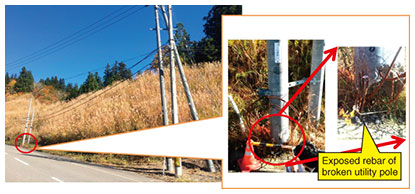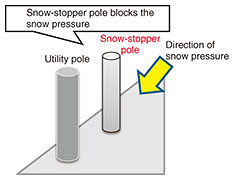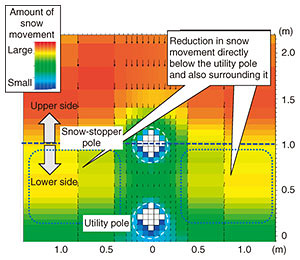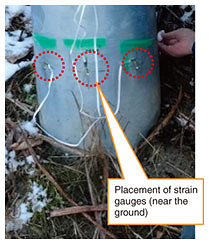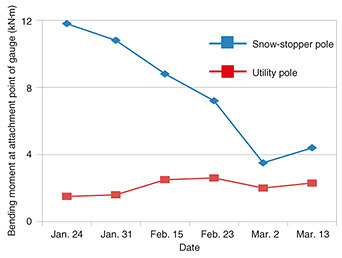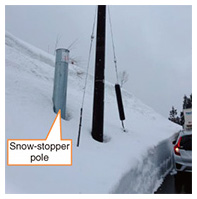 |
|
|
|
|
|
Practical Field Information about Telecommunication Technologies Vol. 16, No. 10, pp. 83–86, Oct. 2018. https://doi.org/10.53829/ntr201810pf1 Snow-stopper Pole as a Countermeasure for Preventing Snow Damage to Utility PolesAbstractNTT works diligently to inspect and maintain equipment to ensure that information and communication services can be provided to customers. Utility poles also require maintenance, as they can incur damage caused by the outdoor environment, including the effects of heavy snowfall. This article presents a countermeasure to reduce the amount of damage that occurs due to snow loading. This is the forty-eighth article in a series on telecommunication technologies. Keywords: utility pole, snow damage, snow-stopper pole 1. IntroductionUtility (i.e., telephone) poles are located throughout the country to deliver ICT (information and communication technology) services provided by NTT. The utility poles installed along the slopes of mountains in regions with heavy snowfall may suffer from damage (snow damage hereafter) such as cracks and breaks in the concrete due to the effect of snow loading by snow cover. We conducted a survey on snow damage in regions with heavy snowfall and studied countermeasures against such damage. In this article, an example of snow damage to utility poles is given, a countermeasure to prevent such damage is proposed, and the results of an on-site verification of the proposed method are presented. 2. Example of snow damage to utility poleAn example of breakage of a concrete utility pole located in a mountainous region that experiences heavy snowfall is shown in Fig. 1. In this example, breaks in the concrete of a utility pole affected by snow damage occurred near the ground. The concrete was crushed, and the rebar inside the utility pole was exposed. Moreover, at the site shown in Fig. 1, there are no trees on the slope of the hillside above the utility pole, and Japanese pampas grass (Miscanthus sinensis) grows wild. Therefore, it is conceivable that lumps of snow on the hillside combine with each other to become a massive deposit of snow with heavy snow pressure that piles up on the dry grass with lower frictional resistance. Thus, snow damage can easily occur at this site.
A common countermeasure for reducing the impact of snow damage is to plant trees on mountain slopes and install snow fences or avalanche bridges; however, such countermeasures require large-scale civil engineering work on slopes. Therefore, we focused on protecting utility poles from the pressure of large deposits of snow and proposed a snow-stopper pole as a low-cost and simple measure to prevent snow damage. 3. Measure to prevent snow damage: snow-stopper poleAs a countermeasure against snow damage, the snow-stopper pole (about 6 to 7 m in length and 40 to 50 cm in diameter) was set up close to the utility pole (on the upper side of the slope) about 1 m from the utility pole (Fig. 2). The snow-stopper pole will alleviate the snow pressure applied to the utility pole positioned below the snow-stopper pole by receiving the snow pressure. The snow-stopper poles are set to be about 40 to 50 cm in diameter, approximately the same size as the utility pole, which enables NTT construction contractors to install the poles themselves without having to undertake large-scale civil engineering work. Since the maximum snow depth in the area where a field trial with the pole was carried out is about 4 m, and the pole should be embedded 2 to 3 m deep, the total length of the snow-stopper pole was set to 6 to 7 m. The separation distance between the snow-stopper pole and the utility pole was set to about 1 m. The effect of the snow-stopper pole was verified by both computer simulation and actual measurements in the field.
4. Verification of effectiveness of snow-stopper pole (simulation of flow mechanism of snow)The snow-stopper pole is not a structure that supports the snow with its width in the manner of snow fences or avalanche bridges. Accordingly, the fact that snow can go around the snow-stopper pole down to the utility-pole sideĦ½and possibly negate the effect of reducing snow pressure on the utility poleĦ½was a major concern. To clarify that effect, a computer simulation was conducted to evaluate the way snow flows around the snow-stopper pole. In the simulation, it was assumed that snow is a viscous body, and the simulation parameters related to snow refer to snow quality in the area where the field trial was carried out. The simulation results shown in Fig. 3 are represented as a top view of the slope on which the snow-stopper pole and utility pole are installed. The direction in which snow flows is indicated by the arrows, and the amount of snow movement on the slope is shown as a color distribution. The simulation results confirmed that snow largely flows in the downward direction of the slope. In the vicinity of the snow-stopper pole, the flow vectors in the downward direction slightly wrap around the snow-stopper pole and utility pole; even so, no increase due to the effect of the wraparound vectors can be seen in the amount of snow movement between the snow-stopper pole and the utility pole.
This result suggests that the effect of the wraparound snow is small when the separation between the snow-stopper pole and the utility pole is about 1 m. The simulated distribution of snow movement also shows that the amount of snow movement on the lower side of the snow-stopper pole is reduced not only just below the snow-stopper pole but also in the areas to the lower left and right of the pole. This result indicates that the snow around the upper side of the snow-stopper pole is supported by the snow-stopper pole as a mass with a certain width. 5. Verification of effectiveness of snow-stopper pole (in-field measurement of stress due to snow pressure)Installing snow-stopper poles as a countermeasure against snow damage is expected to be effective based on the results of the computer simulation described in the last section. Nevertheless, to verify the effectiveness more concretely and quantitatively, the snow pressure applied to the snow-stopper pole and utility pole was evaluated in the field. Stress on the snow-stopper pole and utility pole caused by snow pressure was evaluated by installing strain gauges on the base part of a utility pole and a snow-stopper pole installed exclusively for this test (near the ground, as shown in Fig. 4). Both the snow-stopper pole and utility pole for this test were made of steel and had the same specifications (9.5 m/16 kN/STK490) with no overhead equipment attached. This test was performed from December 2016 to March 2017. The amount of snowfall during this period was less than usual for the area, and the maximum snow depth was about 2 m.
The results of evaluating applied stress due to snow pressure on the snow-stopper pole and utility pole by using strain gauges (Fig. 5) confirmed that the stress received by the utility pole was greatly reduced compared with that received by the snow-stopper pole. For example, the measurements taken on January 24 indicate that the magnitude of the stress received by the utility pole was reduced to about one-eighth of that received by the snow-stopper pole. Moreover, the stress received by the snow-stopper pole changes significantly with time, but the stress received by the utility pole was fairly constant. The snow-stopper pole receives the snow pressure directly from the snow on the slope above it, so the applied stress changes according to the fluctuation in the amount and depth of snow on the slope. In contrast, the utility pole receives snow pressure due to snow between itself and the snow-stopper pole as well as snow in the surrounding area. It is thus inferred that the snow on the slope does not move much, so the applied stress maintains a constant value to some extent.
6. Concluding remarksAn example of snow damage to a utility pole was described, and the results of verifying the effectiveness of a countermeasure against such damage using a snow-stopper pole were presented. The verification results confirm the effectiveness of the snow-stopper pole in significantly reducing the snow pressure applied to the utility pole. In consideration of that result, snow-stopper poles have been installed at sites of utility poles in current use on a trial basis, and these trial installations have confirmed that as of the present time, no new cracks due to snow pressure have occurred in the utility poles (Fig. 6). The plan is to continue such trials in the future.
|

